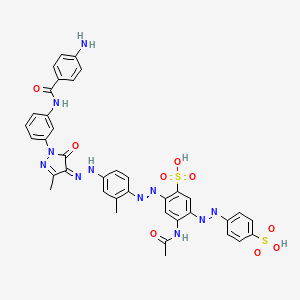|
Name: N-(2-fluorophenyl)-2-methoxy-N-(1-phenethylpiperidin-4-yl)acetamide Oliceridine (N-[(3-methoxythiophen-2-yl)methyl] ({2-[(9R)-9-(pyridin-2-yl)-6-oxaspiro [4.5]decan-9-yl]ethyl{time} )amine fumarate)
Type: Opioid
AKA: N/A
![N-(2-fluorophenyl)-2-methoxy-N-(1-phenethylpiperidin-4-yl)acetamide Oliceridine (N-[(3-methoxythiophen-2-yl)methyl] ({2-[(9R)-9-(pyridin-2-yl)-6-oxaspiro [4.5]decan-9-yl]ethyl{time} )amine fumarate) image](https://grammasearch.com/dev/v2/img/synthopiod.png)
|
|
II. Natural Derivative
Synthetic substance, no natural derivative
 |
|
III. Chemical Profile (IUPAC name)

|
|
IV. History
Oliceridine is a novel opioid analgesic approved by the FDA in 2020. It was developed to provide pain relief with a reduced risk of respiratory depression compared to traditional opioids. Oliceridine selectively targets the G protein pathway, which is believed to mediate analgesia, while minimizing activation of the beta-arrestin pathway associated with adverse effects. Its development represents a significant advancement in opioid pharmacotherapy.

|
|
V. Legal Information
Oliceridine, a novel opioid analgesic, is classified as a Schedule IV controlled substance in the US. It is regulated due to its potential for abuse but is used medically for pain management. Globally, its legal status is similar, with controls focused on managing its use to prevent misuse while allowing for medical applications.
US Federal Schedule - II
Schedule II drugs, substances, or chemicals are defined as drugs with a high potential for abuse, with use potentially leading to severe psychological or physical dependence. These drugs are also considered dangerous. Some examples of Schedule II drugs are: combination products with less than 15 milligrams of hydrocodone per dosage unit (Vicodin), cocaine, methamphetamine, methadone, hydromorphone (Dilaudid), meperidine (Demerol), oxycodone (OxyContin), fentanyl, Dexedrine, Adderall, and Ritalin.
Key US Federal Policies:
Controlled Substances Act. Public Law: Public Law 91-513 (text can be found on GovInfo) (https://www.dea.gov/drug-information/csa). Date enacted: October 27, 1970.
|
|
VI. Physical Effects
Oliceridine, a synthetic opioid, is used for pain management. As a downer, it provides significant analgesia and sedation. Short-term effects include pain relief and drowsiness, while long-term use may lead to dependence and respiratory depression. Overdose risks involve severe respiratory issues and potential fatality. Safe dosing involves careful medical supervision. Recent findings focus on its efficacy in pain management and the need for monitoring due to its high potency.  |
|
VII. Psychological Effects
Oliceridine, an opioid receptor modulator, affects opioid systems to provide pain relief with fewer side effects. Psychological effects include altered mood and potential cognitive issues. Long-term use carries risks of dependence. Research focuses on its safety, efficacy, and potential for abuse compared to traditional opioids.
 |
|
VIII. Culture
Oliceridine, a novel opioid analgesic, represents advancements in pain management with a potentially lower risk of adverse effects compared to traditional opioids. Its cultural significance lies in its contribution to the ongoing efforts to develop safer and more effective pain relief options. Oliceridine highlights the evolving landscape of opioid pharmacotherapy and the continuous search for solutions to the opioid crisis. Its role in the cultural narrative is one of hope and innovation, reflecting the promise of new approaches to managing pain while minimizing the risks of abuse and dependency.
 |
